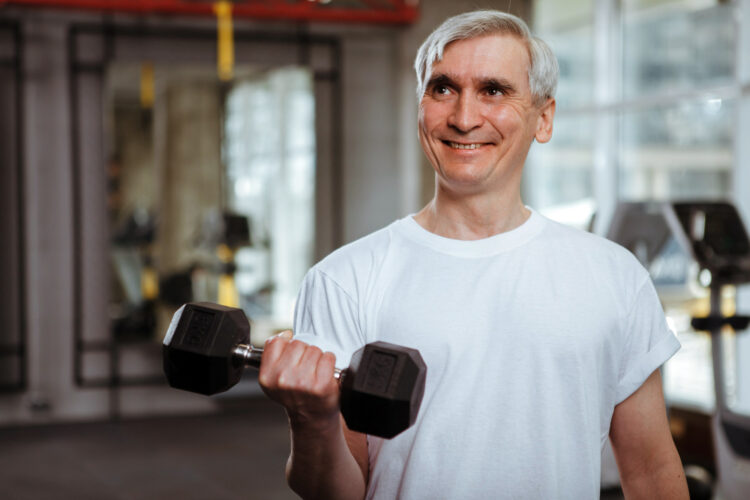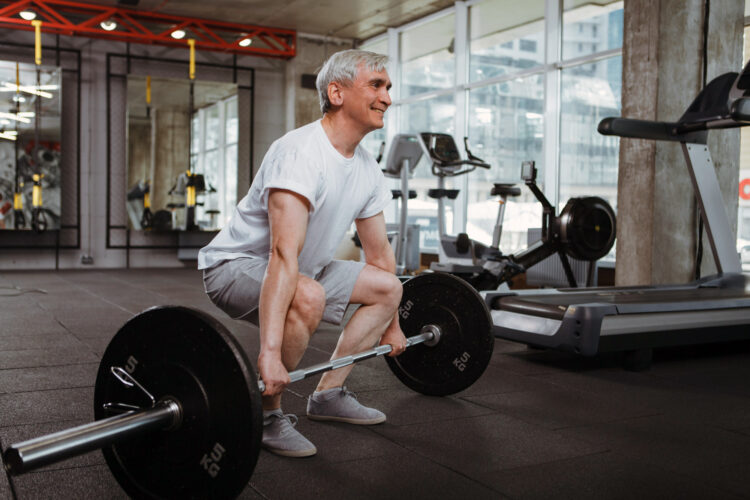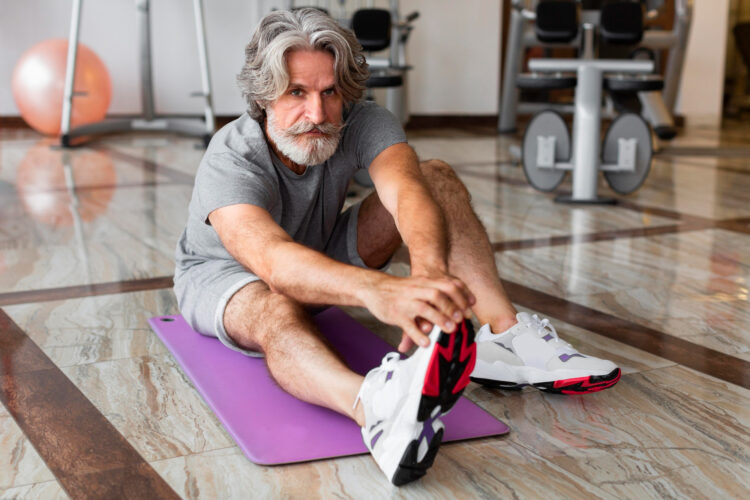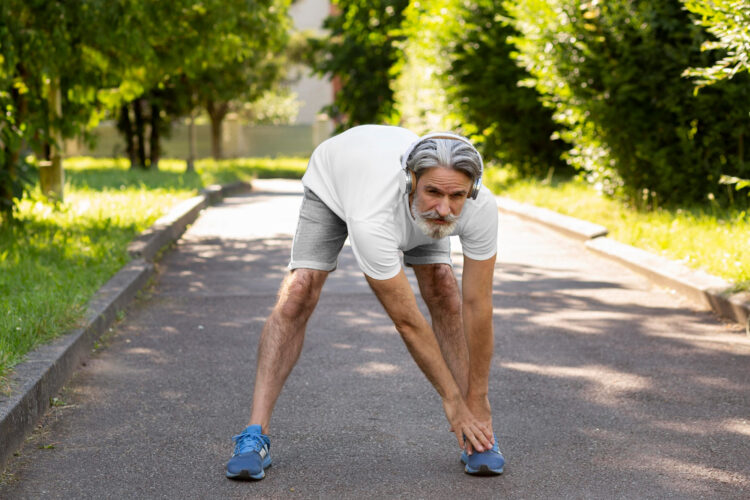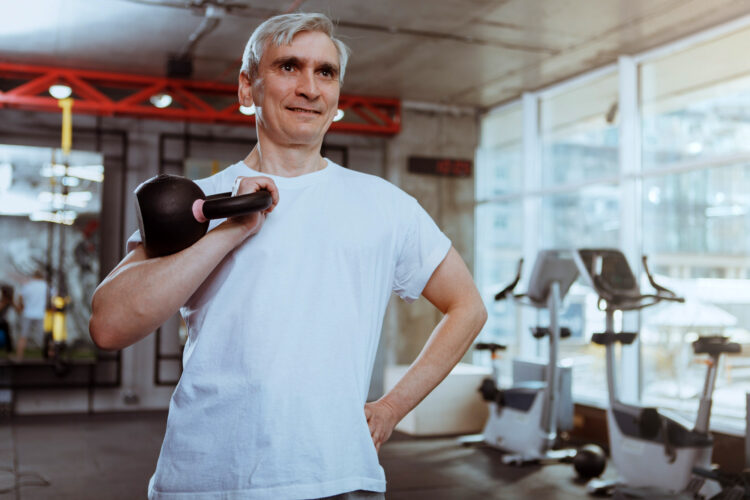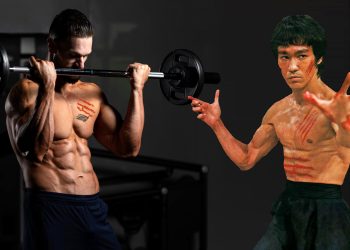Irrespective of who you are, where you are from, what you do, and how much money you have in your bank account — you will age.
The biggest problem with aging is that it can lead to several health issues. While the elite have been exploring ways to slow down aging, there hasn’t been much progress.
However, there is one tried and true way that you can fight back and age gracefully — exercise.
Scientific studies suggest that regular exercise can boost longevity and reduce many major mortality risk factors, including arterial hypertension, type 2 diabetes, dyslipidemia, coronary heart disease, stroke, and cancer. (1)
Exercise is especially effective in preventing age-related muscle loss, also known as sarcopenia. Besides this, old age can make our joints creaky, and we might find ourselves losing our balance more often. Although these are part and parcel of getting older, you can stop a steep decline.
An effective antiaging fitness plan comprises strength, flexibility, and balance training. In this article, I reveal the secrets you need to know to slow down aging and stay strong, mobile, and balanced. We have a lot to unpack, so sit tight and read on.
Level Up Your Fitness: Join our 💪 strong community in Fitness Volt Newsletter. Get daily inspiration, expert-backed workouts, nutrition tips, the latest in strength sports, and the support you need to reach your goals. Subscribe for free!
Strength Training for Seniors
Contrary to what most people think, strength training isn’t just about packing on more muscle mass. It can also help you maintain overall health and well-being as you age. Our bodies start losing muscle mass and bone density naturally as we get older. Strength training can help combat this, helping reduce the risk of fall injuries and chronic diseases.
Besides helping retain muscle tissue, strength training can also boost metabolism. Muscle tissue is more metabolic active, meaning it burns more calories even when you are not physically active. This can be incredibly helpful in maintaining an optimal weight.
Strength training puts stress on the bones, triggering the body to respond by increasing bone density, which can help prevent osteoporosis.
Finally, strength training can improve your overall functionality, boost your performance in day-to-day activities, and enhance your independence and quality of life as you get older.
Debunking Common Myths
There are several misconceptions about strength training, which keep people from adopting it, especially in their senior years. These are the things that you should know about:
Strength Training is Not Dangerous For Seniors
When done correctly and using the right technique, strength training is safe and effective for people of all ages, including seniors. The key is to start small and gradually increase the intensity and volume as you gain more experience.
You Must Lift Heavy To See Results
This is one of the most obnoxious myths that I hear as a personal trainer. For most seniors, the goal isn’t to build a ton of muscle. The primary objective is to prevent muscle tissue loss.
Bodyweight Exercises for Muscle Retention
Bodyweight exercises are excellent for seniors as they are unintimidating, can help retain muscle tissue, and can be done anywhere and at any time. Here are the exercises that I recommend to my senior clients:
- Squats: These work your quads, hamstrings, glutes, and core. Stand upright with a shoulder-width stance and lower your body as far as your mobility allows. Keep your torso upright and core braced throughout the movement.
- Lunges: This exercise works almost all the same muscles as the squat. Step forward with one leg and lower until the rear knee touches the floor. Return to the starting position and repeat on the other side.
- Push-ups: These bias the chest, triceps, shoulders, and core. Get into a higher plank position and flex your elbows to lower your chest to the floor. Explode back to the starting position.
- Planks: This isometric exercise targets the core, shoulders, back, and glutes. Get into a low plan position with your forearms on the floor and parallel to each other. Hold this position for as long as possible.
- Glute Bridges: It works the glutes, hamstrings, and lower back. Lie supine on the floor with your knee bent and feet flat on the ground. Drive your hips towards the ceiling so your body forms a straight line from your shoulders to your knees.
Resistance Training with Weights or Bands
Once you get strong enough, you can graduate to resistance training with weights or bands. This will increase the challenge and ensure you don’t hit a strength or muscle plateau.
Some of the most effective resistance training exercises for seniors include bicep curls, tricep extensions, overhead presses, and rows.
Flexibility and Mobility Exercises For the Elderly
Flexibility and mobility are a crucial piece of the anti-aging puzzle, as they can help combat creaky joints and stiff muscles.
Importance of Flexibility
Optimal flexibility ensures a better range of movement, which can improve your overall functionality. Seniors with better mobility will find reaching the top shelf, tying their shoes, and navigating stairs much easier.
Furthermore, flexibility plays a significant role in injury prevention. People with stiff joints are at a higher risk of strains, and they are just one unexpected movement away from an injury.
Remember, flexibility does not work in isolation. It also plays a significant role in your balance, body control, and stability.
Dynamic Stretching
There are two main types of stretching — dynamic and static. Dynamic stretching involves moving your muscles and joints through their full range of motion. This can help improve your mobility and can be used to warm up the target muscles before a workout.
The most common types of dynamic stretches involve arm circles, leg swings, and torso twists.
Static Stretching
Static stretching involves holding a particular position for an extended period, usually around 30 seconds. While dynamic stretches are more effective when done before a workout, static stretches should be a part of your post-workout routine. (2)
Hamstrings, quads, hip flexors, and calf stretches are some of the most essential static stretches that should be a part of your arsenal.
Static stretches are all about lengthening the muscles and increasing their flexibility over time. Remember, you must ease into each stretch and hold it steady. Avoid bouncing, as it can place undue stress on the muscles and joints.
Level Up Your Fitness: Join our 💪 strong community in Fitness Volt Newsletter. Get daily inspiration, expert-backed workouts, nutrition tips, the latest in strength sports, and the support you need to reach your goals. Subscribe for free!
Yoga and Pilates for Mobility
Yoga and Pilates are an incredibly effective way of improving your flexibility and balance. They are especially great for seniors as they can improve range of motion, build core strength, and enhance body awareness.
The best thing about yoga is that there are countless poses that you can choose from depending on your current flexibility and balance. Some of the more appropriate poses for seniors include the warrior, triangle, and downward-facing dog. These can help strengthen the muscles and improve joint mobility.
Pilates also involves controlled movements and constant core engagement, which can be a boon for the elderly. Exercises like the roll up, hundred, and teaser can help improve core strength and posture and boost flexibility.
Balance Exercises for Fall Prevention
Falls are arguably one of the biggest health hazards for older adults. These can lead to injuries, loss of independence, and even death in some cases.
The risk of falls increases with age but can be controlled through targeted exercise. These workouts will primarily focus on improving balance, strength, and coordination to enhance stability.
Simple Balance Drills
Here are the three most simple balance exercises that can be done anywhere:
- Single-leg stances: Stand on one leg with the other slightly raised in front of you.
- Heel-toe walks: Walk a straight line on your heels with your toes raised towards the ceiling.
- Standing on an unstable surface: Stand straight on an unstable surface, such as a pillow.
Tai Chi and its Benefits
Tai Chi is an ancient Chinese martial art with many health benefits, including improved balance, coordination, and mental well-being. This low-impact exercise can be practiced by people of all ages, including seniors.
The slow, controlled movements of Tai Chi can improve proprioception, which is essential for balance and coordination. It can also help reduce stress and anxiety, improve cardiovascular health and sleep quality, and boost the immune system.
Remember, you must adapt your training routine depending on your current fitness levels and training objectives. Begin with the easier exercises and increase the difficulty as you get stronger and more comfortable.
Sample Weekly Exercise Routine For Seniors
Now that you know everything there is to know about exercising in the golden years, let’s get down to business.
Here is a beginner-friendly four-days-a-week strength, flexibility, and balance training routine for seniors to promote longevity:
Monday: Strength Training
We start the program with a strength training session. Begin by warming up using a five-minute light cardio or dynamic stretching routine. This will get the blood flowing into the target muscles, improve workout performance, and significantly limit injury risk.
Similarly, use a five-minute static stretching routine to cool down after each workout. This helps flush the metabolites out of the muscle tissues and promotes recovery.
Since these strength training workouts are for seniors, you’ll perform just one set of each exercise.
| Exercise | Reps |
| Squats | 10-12 |
| Wall Push-ups | 10-12 |
| Dumbbell Rows | 10-12 |
| Calf Raises | 15-20 |
Tuesday: Flexibility and Balance
The second session of the week will focus on flexibility and balance. I highly recommend beginners join a yoga or Tai Chi class as it will help them drill the movement mechanics.
| Exercise | Time |
| Yoga or Tai Chi | 20-30 minutes |
| Single-Leg Stance | 30 seconds per leg (Repeat 3 times) |
Wednesday: Rest or Active Recovery
Use the third day to give your body a much-needed break from exercise. However, avoid becoming a couch potato and go for a leisurely walk or swim. This will boost blood flow and improve recovery.
These workouts can last anywhere between 10 to 30 minutes.
Thursday: Strength Training
This strength training session introduces new exercises to ensure variability.
| Exercise | Reps |
| Lunges | 10-12 |
| Overhead Press | 10-12 |
| Bicep Curls | 10-12 |
| Bird-Dog | 15-20 |
Friday: Flexibility and Balance
If you don’t want to sign up for a Pilates class, you can instead go for another yoga or Tai Chi session.
| Exercise | Time |
| Pilates | 20-30 minutes |
| Heel-Toe Walk | 20 steps forward, 20 steps back |
Weekend: Active Rest or Your Choice!
As with the previous rest day, the key here is to stay active and enjoy the weekend.
In my experience, most people quit their fitness routine because of unrealistic goals. Don’t try to do too much too soon. Start slowly and increase the training volume and intensity as you gain more experience.
I highly recommend finding an exercise buddy, as they can keep you accountable and motivated.
Conclusion
If you want to ensure peak physical and mental conditioning during the later years of your life, you must make exercise an indispensable part of your lifestyle. Exercise will help keep your body strong, mobile, and independent, even as you rack up those birthdays.
Incorporating the exercise routine detailed in this article can help enhance your quality of life and reduce the risk of age-related decline. Remember, like with any other training routine, consistency, dedication, and discipline are vital for success in this program as well.
If you have any questions about the strength, flexibility, or balance exercises explained in this article, post them in the comments below, and I’ll be happy to help!
References:
- Reimers CD, Knapp G, Reimers AK. Does physical activity increase life expectancy? A review of the literature. J Aging Res. 2012;2012:243958. doi: 10.1155/2012/243958. Epub 2012 Jul 1. PMID: 22811911; PMCID: PMC3395188.
- Samson M, Button DC, Chaouachi A, Behm DG. Effects of dynamic and static stretching within general and activity-specific warm-up protocols. J Sports Sci Med. 2012 Jun 1;11(2):279-85. PMID: 24149201; PMCID: PMC3737866.
- Centers for Disease Control and Prevention. Falls among older adults: data and research. Centers for Disease Control and Prevention. Published November 8, 2024. Accessed November 8, 2024.

